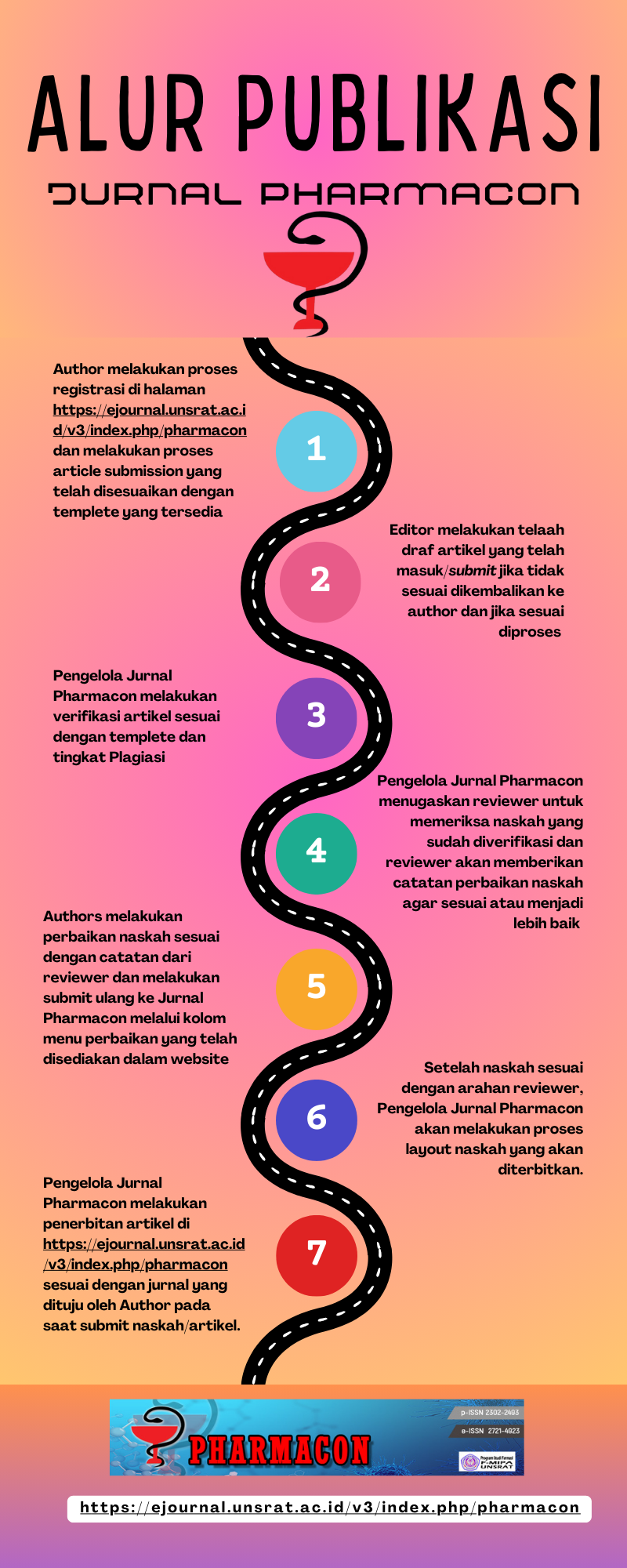FORMULASI SEDIAAN SALEP EKSTRAK ETANOL BAWANG PUTIH (Allium sativum L.) SEBAGAI ANTIBAKTERI
DOI:
https://doi.org/10.35799/pha.10.2021.35604Abstract
ABSTRACT
Garlic (Allium sativum L.) is a plant white bulbs onion that contains antibacterial compounds such as alicin, flavonoid, and saponin. The aim of this study was to formulate an ointment extract of white bulbs onion (Allium sativum L.) with various concentrations of 2,5%; 5%; 7,5%; and 10%, and then evaluated the ointment according to the physical evaluation requirements. The diffusion method was utilized to test the activity of the ointment preparation towards Staphylococcus aureus and Staphylococcus epidermidis. The results showed that garlic (Allium sativum L.) could be formulated as an antibacterial ointment and met the requirements of the ointment evaluation test according to the results of the organoleptic test based on the white ointment, F1 and F2 were pale yellow, and F3 and F4 were brownish yellow with odor lemon. The homogeneity tests indicated no lumps in the ointment preparation, and the pH test revealed that it was within the range of 4.5 to 6.5. The spreadability test met the requirements of 5 - 7 cm, and the adhesion test met the requirements of more than 4 seconds. The results showed that the ethanol extract ointment of garlic (Allium sativum L.) could inhibit the growth of Staphylococcus aureus and Staphylococcus epidermidis bacteria which concentrations of 10 % Staphylococcus aureus resulted in the zone of inhibition of 15.5 mm is categorized as strong and Staphylococcus epidermidis bacteria resulted in the zone of inhibition of 15.1 mm is categorized as strong and F4 is the best formula for generating the zone of inhibition.
Keywords: Garlic (Allium sativum L.), Antibacterial ointment, Staphylococcus aureus, Staphylococcus epidermidis
ABSTRAK
Bawang Putih (Allium sativum L.) merupakan tanaman umbi bawang putih yang memiliki kandungan senyawa alicin, flavonoid dan saponin yang mampu memberikan efek antibakteri. Tujuan dari penelitian ini untuk memformulasikan salep ekstrak etanol bawang putih (Allium sativum L.) dengan berbagai konsentrasi 2,5%; 5%; 7.5%; 10% dan mengevaluasi sediaan salep sesuai dengan persyaratan evaluasi fisik. Pengujian aktivitas sediaan salep terhadap bakteri Staphylococcus aureus dan Staphylococcus epidermidis dilakukan dengan metode difusi. Hasil penelitian menunjukkan bahwa bawang putih (Allium sativum L.) dapat diformulasikan sebagai sediaan salep antibakteri dan memenuhi persyaratan uji evaluasi sediaan salep sesuai dengan hasil uji organoleptik basis salep berwarna putih, F1 dan F2 berwarna kuning pucat, dan F3 dan F4 berwarna kuning kecoklatan berbau lemon. Uji homogenitas menunjukkan tidak adanya gumpalan pada sediaan salep, uji pH sesuai dengan persyaratan yaitu 4.5 – 6.5. Uji daya sebar sesuai dengan persyaratan yaitu 5 – 7 cm, dan uji daya lekat sesuai dengan persyaratan yaitu lebih dari 4 detik. Hasil menunjukkan bahwa salep ekstrak etanol bawang putih (Allium sativum L.) dapat menghambat bakteri Staphylococcus aureus dan Staphylococcus epidermidis dimana konsentrasi 10 % bakteri Staphylococcus aureus menghasilkan zona hambat 15.5 mm termasuk kategori kuat dan bakteri Staphylococcus epidermidis menghasilkan zona hambat 15.1 mm termasuk kategori kuat dan formula F4 merupakan formula terbaik dalam menghasilkan zona hambat.
Kata Kunci : Bawang putih (Allium sativum L.), Salep antibakteri, Staphylococcus aureus, Staphylococcus epidermidis
References
Ansel, 1989. Pengantar Bentuk Sediaan Farmasi. Diterjemahkan oleh Farida Ibrahim. Edisi keempat. UI – Press, Jakarta.
Ajizah, A. Thihana, Mirhanuddi. 2010. Potensi Ekstrak Kayu Ulin (Eusideroxylon Zwageri T Et B) Dalam Menghambat Pertumbuhan Bakteri Staphylococcus aureus Secara In Vitro. Jurnal Bioscientiae.4 (1): 37-42.
Depkes RI, 1995. Farmakope Indonesia Edisi IV. Departemen Kesehatan Republik Indonesia, Jakarta.
Hafsan, 2011. Mikrobiologi Umum. Alauddin Press, Makassar
Jawetz, E, Melnick. 2001. Mikrobiologi Kedokteran Edisi 1. Salemba Medika, Jakarta.
Miranti.2010,Pengaruh Konsentrasi Minyak Atsiri Kencur (Kaemferia galangal) Dengan Basis Salep Larut Air terhadap Sifat Fisik Salep dan Daya Hambat Bakteri Staphylococcus aureus Secara InVitro. Fakultas Farmasi Univeritas Muhammadiyah, Surakarta.
Melati, P., Welly, D. Widiyati. 2009. Uji Efektivitas Ekstrak Daun Ubi Jalar Merah (Ipomoea batatas poir) sebagai Antibakteri Staphylococcus aureus Penyebab Penyakit Bisul pada Manusia. FMIPA Pasca Sarjana, Bengkulu.
Naibaho. 2013, Pengaruh Basis Salep Terhadap Formulasi Sediaan Salep Ekstrak Daun Kemangi (Ocimum sanctum L.) Pada Kulit Punggung Kelinci Yang Dibuat Infeksi Staphylococcus aureus, Jurnal Ilmiah Farmasi. Vol. 2 No. 02.
Nainggola, I.J.J. 2000. Uji Antibakteri: dalam praktikum farmakologi dan terapi PS-05. Bagian Farmakologi dan terapi. Fakultas Kedokteran Unsrat. Manado.
Rahmawati. 2010, Formulasi Krim Minyak Atsiri Rimpang Temu Giring (Curcuma heyneana Val & Zijp): Uji Sifat Fisik dan Daya Antijamur Terhadap Candida albicans Secara In Vitro, Jurnal Obat Tradisional. 15 (2), 56-63.
Ramirez, 2017. Analytical methods for bioactive sulfur compounds in Allium; Journal of Food Composition and Analysus.Vol. 61: 4-19.
Soedarto. 2014. Mikrobiologi Kedokteran : Medical Microbiology. Sagung Seto, Jakarta.
United States Departement of Agriculture. 2016. National nutrient database of standard reference of raw garlic. Departemen of Agriculture United States.
Downloads
Published
How to Cite
Issue
Section
License
Authors who publish with this journal agree to the following terms:
- Authors retain copyright and grant the journal right of first publication with the work simultaneously licensed under a Creative Commons Attribution-NonCommercial 4.0 International License that allows others to share the work with an acknowledgement of the work's authorship and initial publication in this journal.
- Authors are permitted and encouraged to post their work online (e.g., in institutional repositories or on their website) prior to and during the submission process, as it can lead to productive exchanges, as well as earlier and greater citation of published work (See The Effect of Open Access)










